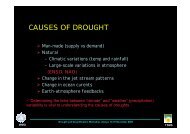training course on weather radar systems - RTC, Regional Training ...
training course on weather radar systems - RTC, Regional Training ...
training course on weather radar systems - RTC, Regional Training ...
- No tags were found...
Create successful ePaper yourself
Turn your PDF publications into a flip-book with our unique Google optimized e-Paper software.
MODULE A- INTRODUCTION TO RADAR<br />
Hydrologists need precipitati<strong>on</strong> measurements. As simple as it looks, as difficult it is to obtain<br />
reliable data. We know that rain gauge measurements have errors, owing to the type of the<br />
instrument and to the site. Wind, snowfall, drop-size influence the results. But the largest problem is<br />
the areal representativeness. Measurements <strong>on</strong> a surface of 200 or 400 cm2 are used to estimate the<br />
rainfall <strong>on</strong> areas in the order of magnitude of 100 km2. Knowing the spatial variability of rainfall,<br />
especially during flood events, it is obvious that point measurements, even if the measurement itself<br />
would be correct, are heavily biased.<br />
The hope of hydrologists and meteorologists is c<strong>on</strong>centrated <strong>on</strong> <strong>radar</strong> measurements. Radar<br />
provides images of instantaneous rainfall intensity distributi<strong>on</strong> over large areas. However, when<br />
trying to obtain the desired quantitative results <strong>on</strong>e encounters a series of problems. Radar measures<br />
an echo, which is influenced by type, size and c<strong>on</strong>centrati<strong>on</strong> of particles, all depending <strong>on</strong> the<br />
meteorological c<strong>on</strong>diti<strong>on</strong>s, ground clutter, shadowing by mountain ridges, attenuati<strong>on</strong> and<br />
parameters of the instrument itself. Calibrati<strong>on</strong> based directly <strong>on</strong> physical data is not possible,<br />
owing to the simple fact that no reliable data are available, since, as indicated above, rain gauge<br />
data are in error too. So <strong>on</strong>e tries to obtain the best possible agreement with point measurements,<br />
being aware, that neither the gauge value nor the <strong>radar</strong> interpretati<strong>on</strong> is necessarily correct.<br />
Therefore, <strong>radar</strong> is, and will be in future as well, a semi-quantitative measurement device.<br />
4<br />
TURKEY RADAR TRAINING 1.0 / ALANYA 2005
















